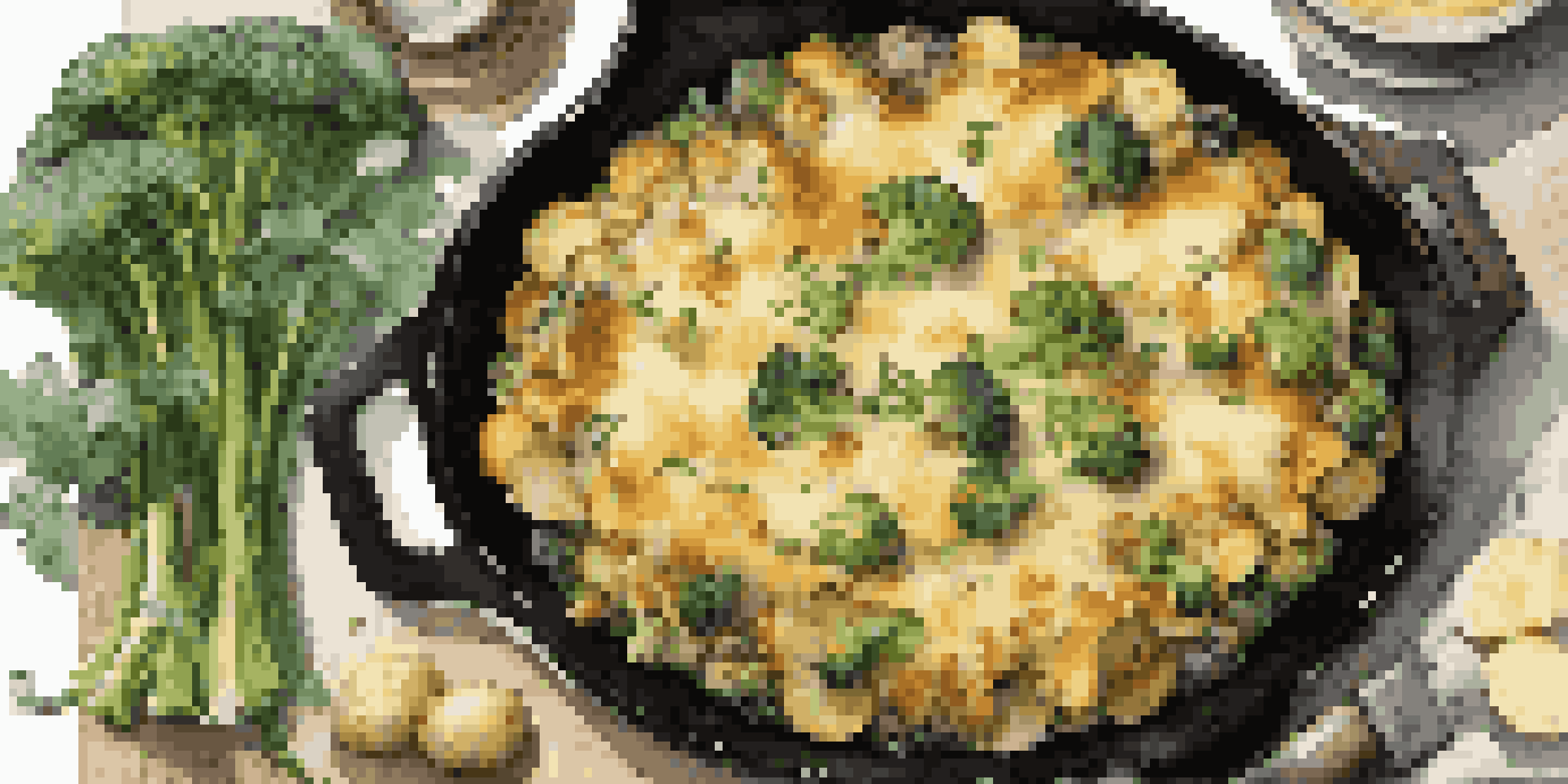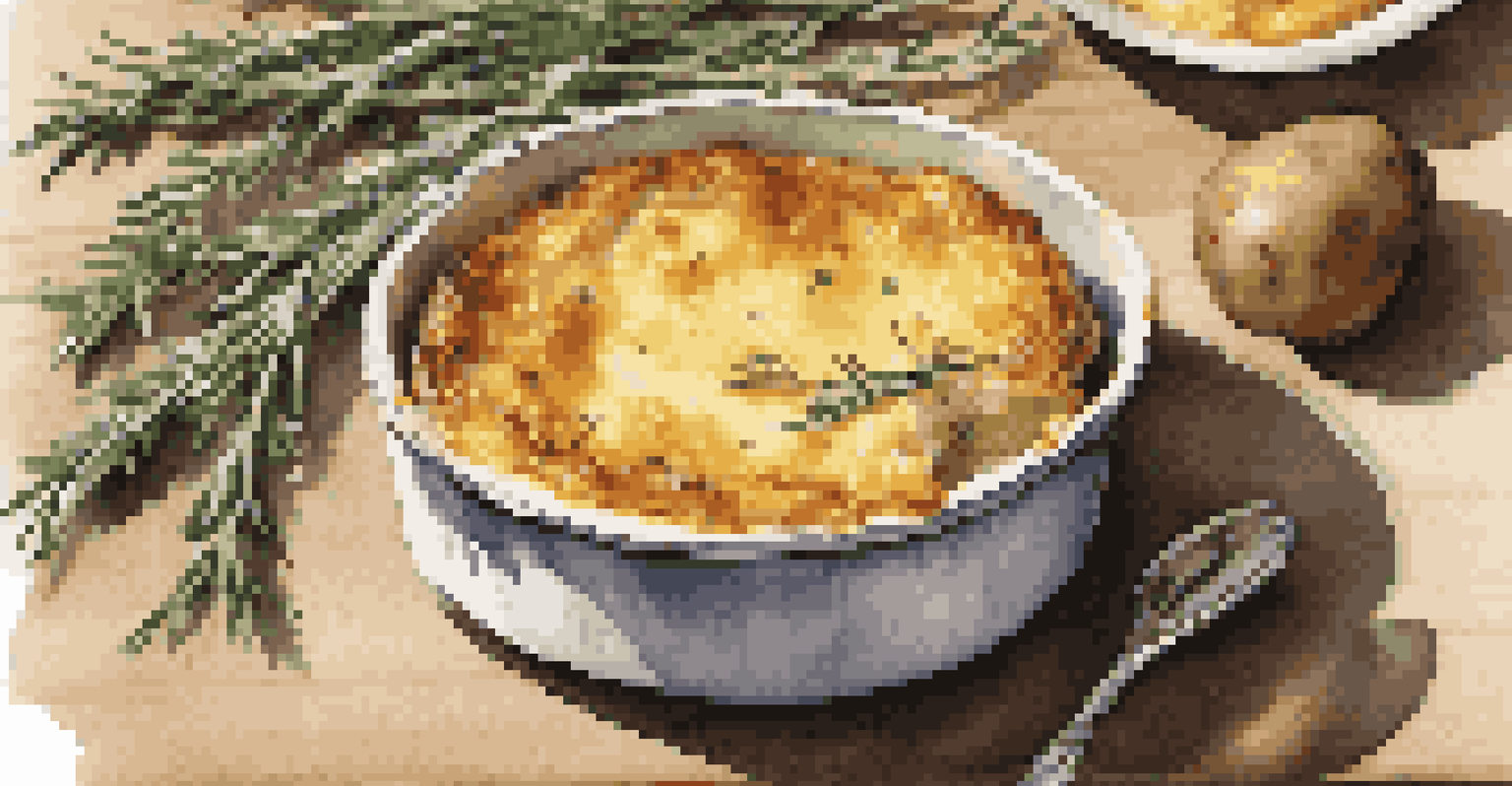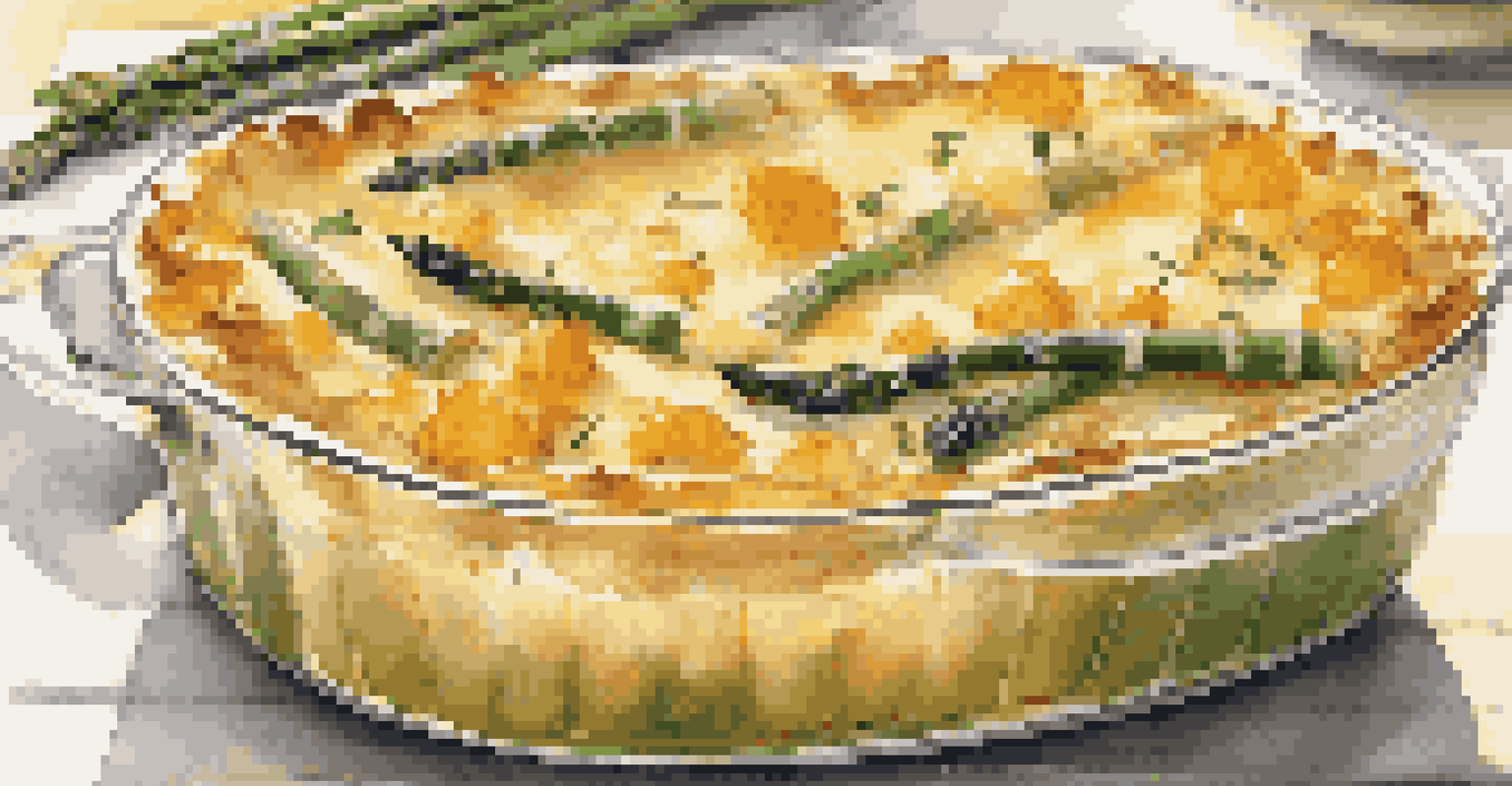Advanced Gratin Techniques: Creating Luxurious Cheesy Dishes

Understanding the Basics of Gratin
Gratin is a culinary term that refers to a dish topped with a browned crust, often made from cheese or breadcrumbs. It’s a classic French technique that transforms simple ingredients into something spectacular. At its core, a gratin combines a base of vegetables, pasta, or potatoes with a creamy sauce and a generous layer of cheese. This combination creates a delightful contrast of textures and flavors.
Cooking is like love. It should be entered into with abandon or not at all.
To achieve that perfect gratin, the key is in the layering. Start with a flavorful base, add your sauce, and then top it generously with cheese. This ensures that every spoonful is filled with rich, cheesy goodness. The magic happens when you pop it in the oven, allowing the cheese to melt and create that golden, crispy topping we all crave.
Remember, not all cheeses are created equal! Choosing the right cheese can elevate your gratin from good to extraordinary. For instance, Gruyère offers a nutty flavor, while cheddar brings a sharpness that can cut through the creaminess. Experimenting with different cheeses will help you discover your personal favorite blend.
Choosing the Right Ingredients for Your Gratin
Selecting the right ingredients is crucial for a successful gratin. Start with fresh, high-quality vegetables like cauliflower, broccoli, or potatoes, which can serve as excellent bases. You want to choose ingredients that will hold their texture during cooking, as they will create a hearty foundation for your dish.

Don’t forget about the cream or sauce! A rich béchamel sauce made from butter, flour, and milk is traditional, but you can also use heavy cream or even stock for a lighter option. Adding garlic, herbs, or spices can enhance the flavor profile, making your gratin stand out. The goal is to create a well-balanced dish that sings with flavor.
Explore Unique Flavor Combinations
Experimenting with unexpected ingredients and seasonal produce can elevate your gratin to new heights.
Finally, consider texture when selecting your toppings. While cheese is a must, adding breadcrumbs or crushed crackers can provide an additional crunchy layer. Mixing different textures not only makes the dish more appealing but also adds an exciting element to each bite, inviting your guests to dive in.
Mastering the Art of Layering
Layering is an art form in gratin preparation. It’s all about creating a harmonious balance between your base, sauce, and cheese. Start by placing a layer of your chosen vegetable or pasta in the baking dish, ensuring they are evenly distributed for consistent cooking. Next, pour a layer of your creamy sauce over the top, allowing it to seep into the nooks and crannies.
The secret of good cooking is, first, having a good plate, second, a good chef, and third, a good oven.
After the sauce, it’s time to sprinkle cheese generously on top. This cheese layer should be thick enough to create that coveted crust but not so thick that it overwhelms the other flavors. As you build each layer, think about how the flavors and textures will complement each other, creating a cohesive dish.
Don’t be afraid to get creative with your layering technique! You can alternate between different ingredients or even create a rainbow effect with colorful veggies. The visual appeal of a gratin can be just as important as the taste, making it a dish that’s as beautiful as it is delicious.
Baking Techniques for Perfect Results
Baking is where the magic happens in a gratin. Preheating your oven to the right temperature is essential; typically, a range between 350°F to 400°F works well. This allows the cheese to melt beautifully and the top to crisp up without overcooking the ingredients underneath. A good rule of thumb is to bake until the top is golden brown and bubbly.
Consider using a convection oven if you have one. The circulating hot air can help achieve that evenly cooked crust while keeping the interior moist. If you notice the top browning too quickly, you can loosely cover the gratin with aluminum foil to prevent burning while allowing the rest of the dish to cook through.
Master the Art of Layering
Creating harmonious layers of vegetables, sauce, and cheese is key to achieving a delicious gratin.
Lastly, let your gratin rest for a few minutes after baking. This resting period allows the sauce to thicken slightly and makes serving easier. Patience pays off, as slicing into a freshly baked gratin can sometimes lead to a gooey mess. Allowing it to set ensures clean, beautiful portions for your guests.
Exploring Unique Flavor Combinations
While traditional gratins often feature classic combinations, there's a whole world of flavors waiting to be explored. Think outside the box by incorporating unexpected ingredients like roasted garlic, sun-dried tomatoes, or even truffle oil. These additions can elevate your gratin from a simple side dish to a gourmet experience.
Seasonal ingredients can also inspire creativity. In the fall, consider adding roasted butternut squash or mushrooms, while spring might call for asparagus or peas. The beauty of a gratin lies in its versatility, allowing you to change it up based on what’s fresh and available.
Don’t shy away from experimenting with different cheese blends either. For a spicy kick, try adding pepper jack or a smoky gouda. The right combination of flavors can lead to a gratin that’s not only delicious but also memorable, leaving your guests asking for seconds.
Serving Suggestions to Enhance Your Gratin
Serving your gratin can be just as important as preparing it. A well-presented dish can set the tone for the entire meal. Consider serving your gratin in colorful ramekins for individual portions or in a beautiful cast-iron skillet for a rustic touch. Adding fresh herbs as a garnish can also brighten up the dish and add a pop of color.
Pairing your gratin with complementary side dishes can enhance the overall dining experience. A crisp green salad or steamed vegetables can balance out the richness of the cheese, while a light vinaigrette can cut through the creaminess. Think about how the flavors work together to create a harmonious meal.
Choose Quality Ingredients
Using fresh, high-quality ingredients enhances the flavor and texture of your gratin.
Don’t forget about wine pairings! A creamy gratin pairs well with a crisp white wine, such as a chardonnay or a light pinot grigio. These wines can enhance the flavors of the dish while providing a refreshing contrast, making for a well-rounded dining experience.
Tips for Making Gratins Ahead of Time
Planning ahead can make hosting dinner parties a breeze, and gratins are perfect for this. You can prepare your dish a day in advance, layering ingredients and sauce, then cover it tightly and refrigerate. This allows the flavors to meld, creating an even more delicious result when it’s time to bake.
When you're ready to bake, simply pop the gratin in the oven, adding an extra few minutes to the baking time if it’s coming straight from the fridge. This way, you can enjoy your gathering without spending all your time in the kitchen. Just make sure to monitor it closely to achieve that perfect golden crust.

For those who love to meal prep, gratins can be portioned into individual servings and frozen. Just be sure to wrap them tightly to prevent freezer burn. When you’re ready, thaw and bake, and you’ll have a comforting meal ready in no time. It’s a delicious solution for busy weeknights!